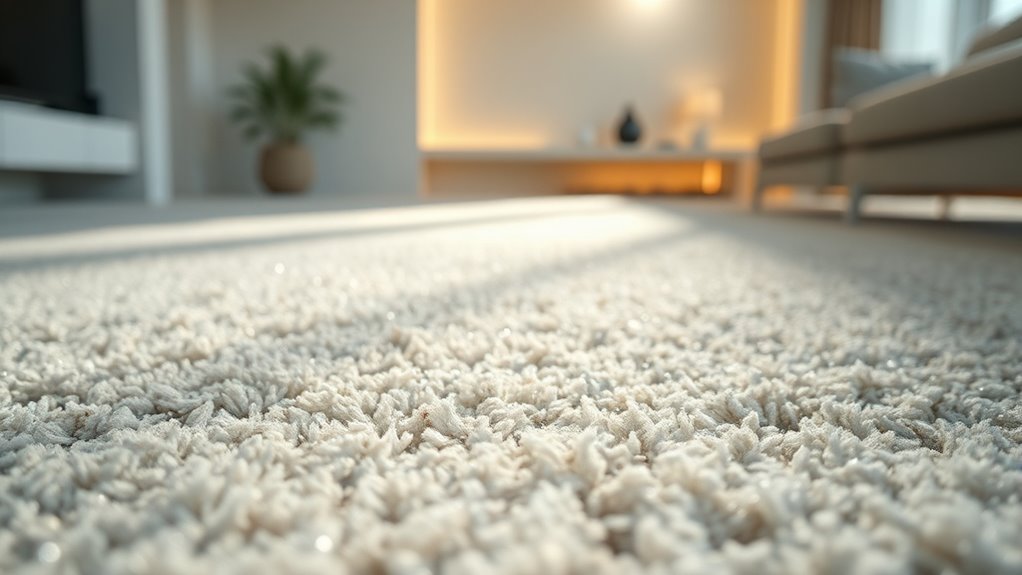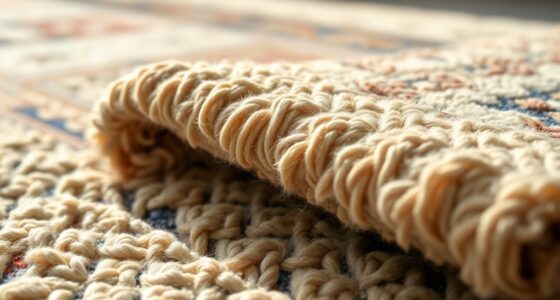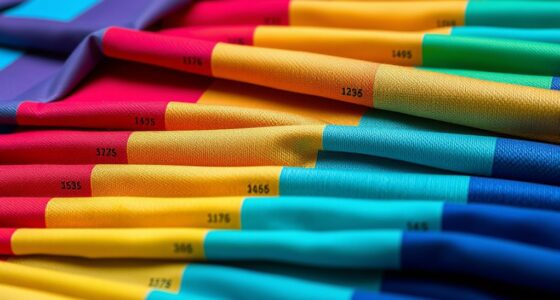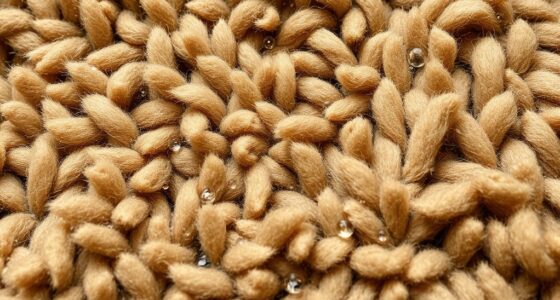Self-cleaning carpet fibers are on the horizon, using advanced nanotech and smart coatings to repel dirt, stains, and microbes. These fibers activate in response to sunlight, moisture, or other triggers to break down contaminants and keep carpets fresher longer. They’re eco-friendly, durable, and reduce maintenance efforts. If you want to find out how these innovations will change your space and future cleaning needs, there’s plenty more to discover beyond this quick insight.
Key Takeaways
- Advanced nanocoatings and embedded nanostructures enable carpets to actively break down dirt and stains using environmental triggers.
- Smart sensors in fibers detect dirt in real-time, optimizing self-cleaning processes and reducing maintenance efforts.
- Eco-friendly materials like biodegradable polymers ensure sustainable disposal and minimize environmental impact.
- Self-cleaning fibers enhance durability, maintain vibrant colors, and extend carpet lifespan in high-traffic environments.
- Future innovations aim to reduce chemical use, improve safety, and create cost-effective, long-lasting cleaning solutions.
How Self-Cleaning Fibers Work
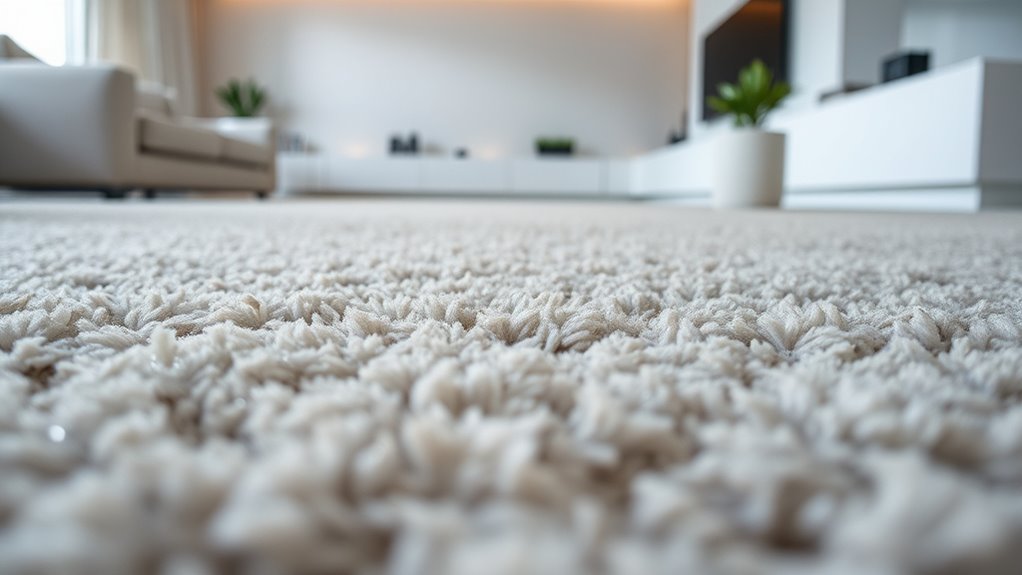
Self-cleaning fibers work by incorporating special coatings or embedded materials that react to dirt, moisture, or UV light to break down or repel stains. This technology relies heavily on nanotechnology applications, which enable the fibers to interact at a microscopic level, enhancing their cleaning capabilities. These nanomaterials create a protective barrier, making the fibers resistant to dirt and spills, while also boosting textile durability. When exposed to environmental triggers like sunlight or moisture, the embedded nanomaterials activate, decomposing organic stains or causing liquids to bead up and roll off. This process reduces the need for frequent cleaning and prolongs the lifespan of the carpet. Overall, nanotechnology-driven self-cleaning fibers combine advanced functionality with increased durability, revolutionizing how we maintain and enjoy carpeted surfaces.
Materials and Technologies Behind the Innovation

The development of self-cleaning carpet fibers relies on a combination of advanced materials and cutting-edge technologies. Nanotechnology applications play a vital role, enabling fibers to repel dirt, bacteria, and moisture at a microscopic level. These tiny particles create a reactive surface that breaks down contaminants using light or heat, reducing the need for chemical cleaners. Additionally, environmentally friendly approaches minimize environmental impact by reducing water and chemical use during cleaning. Here’s a quick overview:
| Material | Technology | Environmental Impact |
|---|---|---|
| Nano-coatings | Photocatalytic reactions | Low chemicals, less waste |
| Hydrophobic fibers | Surface tension manipulation | Water-efficient cleaning |
| Antimicrobial treatments | Embedded nanostructures | Reduces microbial growth |
| Biodegradable polymers | Eco-friendly synthesis | Sustainable disposal |
| Smart sensors | Real-time dirt detection | Efficient cleaning cycles |
These innovations make self-cleaning fibers effective while caring for the environment. A deeper understanding of advanced materials and their properties helps drive further improvements in the technology. Exploring nanotechnology techniques offers promising avenues for enhancing durability and functionality, especially through the development of responsive surfaces that adapt to changing conditions.
Benefits for Homes and Commercial Spaces
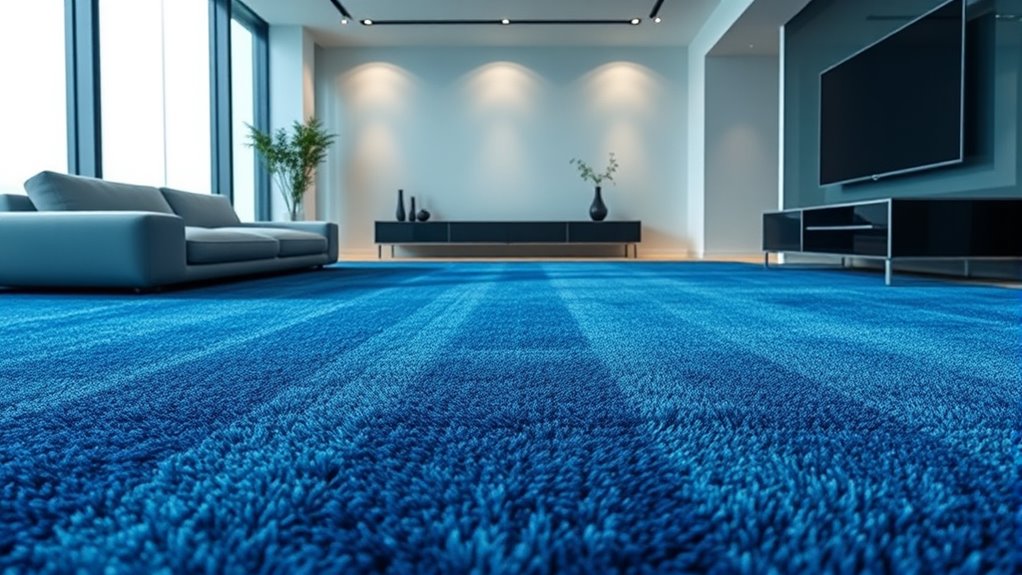
With self-cleaning carpet fibers, both homes and commercial spaces can enjoy significant benefits that improve cleanliness and convenience. These fibers enhance cleaning efficiency by actively breaking down dirt, stains, and allergens, reducing the need for frequent deep cleaning. This means less time and effort spent maintaining carpets, keeping your space fresher longer. Additionally, self-cleaning fibers help preserve the aesthetic appeal of your environment, maintaining vibrant colors and a spotless look over time. In busy homes or high-traffic commercial areas, these benefits translate into a cleaner, healthier space without constant upkeep. Moreover, innovations like Kia Tuning demonstrate how technological advancements can also optimize performance and aesthetics in various applications. Overall, self-cleaning carpet fibers offer a practical solution that combines improved hygiene with a polished appearance, making your spaces more inviting and easier to maintain.
Challenges and Considerations in Development

Developing self-cleaning carpet fibers presents several technical and practical challenges that researchers must address. One major concern is managing maintenance costs; advanced coatings or embedded technologies could be expensive, making the carpets less appealing to budget-conscious consumers. Ensuring durability is also crucial, as the self-cleaning properties need to withstand regular wear and cleaning routines without losing effectiveness. Consumer acceptance plays a significant role in successful adoption—people might be wary of new materials or skeptical about their long-term performance. Educating users on the benefits and reliability of these fibers is essential. Additionally, safety and environmental impact must be considered to gain widespread trust. Environmental impact is a critical factor that influences consumer confidence and regulatory approval. Overcoming these hurdles requires balancing innovation with practicality, ensuring the technology is affordable, effective, and safe for everyday use. Waterparks often incorporate innovative features and could serve as inspiration for designing resilient, self-cleaning surfaces in high-traffic environments. Furthermore, understanding the AI security implications of new materials and their integration into smart cleaning systems is vital to prevent potential vulnerabilities. Incorporating sustainable materials can also help address environmental concerns and promote long-term adoption.
The Future Impact on Daily Life and Sustainability
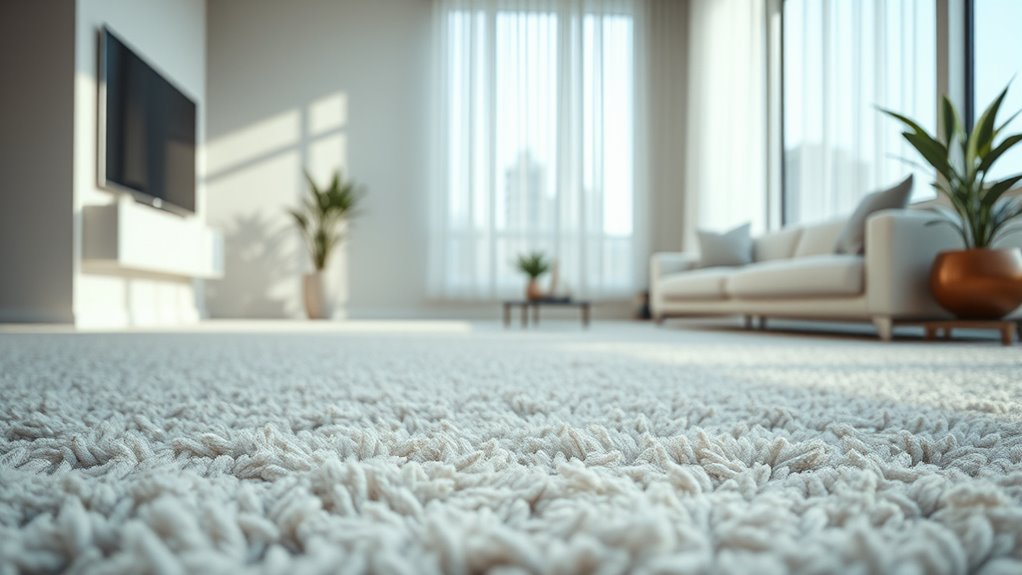
As self-cleaning carpet fibers become more widespread, they are poised to transform daily life by reducing the time and effort spent on maintenance. You’ll find carpets stay cleaner longer, saving you both time and energy. This innovation can also positively impact the environment by decreasing the need for harsh cleaning chemicals and frequent replacements, lowering your carbon footprint. As more consumers adopt these fibers, demand for sustainable manufacturing practices will grow, encouraging eco-friendly innovations across the industry. The reduction in cleaning resources not only benefits your household but also supports sustainability efforts on a larger scale. Additionally, these fibers are designed to be environmentally friendly, further enhancing their appeal to eco-conscious consumers. Moreover, celebrity lifestyle insights, such as private paradises, showcase how luxury and sustainability can coexist in modern design. As the technology advances, the integration of eco-friendly materials into everyday products will likely become more prevalent, fostering a more sustainable lifestyle. The development of renewable resources for fiber production is expected to accelerate, further minimizing environmental impacts. Overall, self-cleaning carpet fibers promise a future where cleaning is less of a chore, and environmental impact is minimized, making daily living easier and greener.
Frequently Asked Questions
How Durable Are Self-Cleaning Carpet Fibers Over Time?
You’re curious about how durable self-cleaning carpet fibers are over time. Generally, fiber longevity depends on the materials used and how well you maintain your carpet. These fibers are designed for consistent cleaning efficiency, even after years of use. While some may experience slight wear, many self-cleaning fibers maintain their functionality longer than traditional ones, ensuring your carpet stays fresh and clean, saving you time and effort in maintenance.
Are Self-Cleaning Fibers Safe for Children and Pets?
Ever wondered if self-cleaning fibers are safe for your little ones and pets? You might ask, “Are these fibers free from harmful chemicals?” Rest assured, manufacturers prioritize chemical safety and allergen concerns, designing fibers that are non-toxic and hypoallergenic. While ongoing research continues, current self-cleaning carpet fibers aim to keep your home healthier, making your family safer without sacrificing cleanliness.
Can These Fibers Be Integrated Into Existing Carpets Easily?
You can integrate self-cleaning fibers into existing carpets, but there are some installation challenges to consider. It’s essential to verify the fibers are compatible with your carpet’s material and color. You might need professional help for seamless blending and proper installation. While the technology is promising, checking color compatibility and addressing installation challenges beforehand will help you achieve the best results and avoid mismatched appearances.
What Maintenance Is Required for Self-Cleaning Carpets?
Imagine never stressing over stains again—sounds like a dream, right? With self-cleaning carpets, your maintenance becomes simple. You’ll need to monitor cleaning frequency to keep them fresh, and stain removal is often automatic. Usually, minimal effort is required, like occasional vacuuming or cleaning sensors. This technology transforms your space, making upkeep effortless and freeing you from constant worry about spills or dirt.
How Cost-Effective Are Self-Cleaning Fibers Compared to Traditional Carpets?
You’ll find that self-cleaning fibers are more cost-effective over time compared to traditional carpets. The initial installation costs might be higher, but they save you money by reducing cleaning and maintenance expenses. The cost comparison shows fewer replacements and less frequent deep cleaning, making them a smarter investment. Overall, you’ll spend less on upkeep and enjoy cleaner carpets longer, which benefits your budget and peace of mind.
Conclusion
Imagine a world where your carpets stay spotless without lifting a finger, like Cinderella’s enchanted gown. These self-cleaning fibers are poised to revolutionize your daily life, making maintenance effortless and eco-friendly. As technology advances, you’ll enjoy cleaner homes and a smaller environmental footprint. Just as the future once seemed like magic, these innovations promise a smarter, cleaner world—turning dreams into reality, one fiber at a time.
